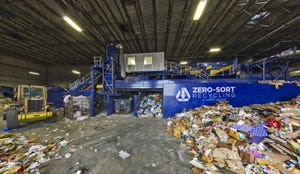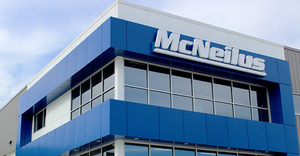Exhausting Regulations
It's going to be a busy summer for Billy Cecil, equipment performance director for Houston-based Waste Management (WM). That's because he's the man in charge of monitoring the field tests of five 2007 model trucks WM is going to receive. During the tests, he will be examining the trucks with a fine-tooth comb for spec'ing nuances that could impact how WM operates and maintains its refuse fleet.
“The major area we're looking at is the exhaust system — how higher exhaust temperatures and the need to actively regenerate the new diesel particulate filter [DPF] all new trucks must have in '07 are going to affect our operation and maintenance patterns,” he says.
Cecil adds that he will also be recording extensive data on every facet of the '07 model trucks including fuel economy, exhaust temperatures and how often DPF regeneration occurs, and log any maintenance that's required. “This is what's going to form the basis of our overall fleet training for drivers and technicians heading into '07,” he says.
Though WM's five test trucks — which are from Portland, Ore.-based Freight-liner; Hagerstown, Ind.-based Autocar; and Allentown, Pa.-based Mack Trucks — represent only a drop in the bucket of WM's total fleet of 25,000 vehicles, the test data will help Cecil determine which specifications and maintenance practices may change and which won't.
“Right now, we only have assumptions to go on, largely because most of the engine and truck OEMs [original equipment manufacturers] performed most of their '07 testing on highway tractors,” Cecil says. “We need to establish for ourselves what the performance characteristics of these '07 trucks are before we attempt to put together training programs to educate our workforce about them.”
Exhaust Matters
Starting in 2007, the U.S. Environmental Protection Agency (EPA), Washington, will require new diesel engines to slash their emissions of particulate matter, oxides of nitrogen and non-methane hydrocarbons. Industry observers have estimated that the price of vocational chassis could increase around $10,000 per unit, in large part because of aftertreatment systems such as DPFs mandated by the regulations.
Overall, truck experts do not foresee a dramatic impact on truck specifications. However, refuse operators do need to prepare for spec'ing changes in exhaust systems.
Horizontal exhaust systems release exhaust under the chassis, while vertical systems release the fumes between the truck cab and body. Many OEMs are no longer going to offer the horizontal option, says Steve Ginter, vocational products marketing manager at Mack Trucks. “We're only going to offer a vertical exhaust set-up for our '07 MR and LE models,” he adds.
While some OEMs, notably Warrenville, Ill.-based International Truck & Engine Corp., are still going to offer the horizontal option, they are strongly recommending that most customers go vertical, says Melissa Gauger, International's marketing manager for vocational products.
“The main reason for that is refuse operators are going to need active regeneration to clear their DPFs, as their typical stop-and-go operating environment doesn't allow the engine to build up sufficient heat to ‘passively’ clean out the DPF,” she says. “That means we're going to see a significant increase in exhaust temperatures during active regeneration — from 800 to over 1,200 degrees Fahrenheit — and our concern is that, with a horizontal exhaust, leaves or other loose material underneath a truck undergoing active regeneration could ignite.”
Exhaust system changes are “the single biggest '07 issue faced by vocational fleets,” says Matt Stevenson, manager of product strategy for Redford, Mich.-based Sterling Truck Corp. Until now, haulers and manufacturers have had a significant degree of flexibility when deciding exactly where to place the exhaust system and have been able to move it even after a truck began operations.
However, an exhaust system won't be able to be relocated after manufacturers certify to the EPA that a truck chassis meets the 2007 requirements. That's one reason why WM's Cecil is going to monitor the exhaust systems very closely during field tests.
“Because an exhaust system can't be moved or modified, it not only means the refuse body installer needs to take that into consideration, it also means we need to make sure no loose trash or other debris gets trapped near the exhaust system, as there'll be a big increase in heat,” he says. “The added heat from both the exhaust and induction systems are two areas we'll need to watch closely.”
The additional heat is not too much of a worry for WM, Cecil says, since the 400 or so liquid natural gas- (LNG) powered refuse trucks in the firm's fleet produce nearly 1,000-degree heat, Cecil says.
“LNG burns much more cleanly — and thus far hotter — than diesel,” Cecil explains. “The upshot is that we've already had to adjust routes and operating styles to account for higher exhaust temperatures, so it's a situation we've had extensive experience with.”
To help control the spike in exhaust heat, most truck OEMs are going to offer a “diffuser,” a cap for the tailpipe studded with holes intended to reduce exhaust temperatures and therefore dissipate heat from active regeneration safely. Though experts say the extra cost to add a diffuser to an exhaust tailpipe will be minimal, it's going to remain an optional component, largely because the exhaust heat is only expected to spike for very short intervals over the course of a refuse truck's working day.
“Right now, active regeneration occurs for about 10 minutes for every five hours of collection work,” Mack's Ginter says. “Now, those 10 minutes can occur while the vehicle is on the road, driving from trash pick-up points to the landfill or disposal center, [in which case] a diffuser wouldn't be needed. Also, when the system is not regenerating, exhaust heat is comparable to the tailpipe temperatures of today's waste trucks.”
The Lowdown on DPFs
The DPF is another piece of the exhaust system that haulers will be watching carefully as the 2007 emission story unfolds. Like today's diesel mufflers, the DPF, which will replace mufflers in 2007, can still be mounted underneath the chassis, but is slightly larger in diameter than a muffler.
The extra width of a DPF will have a minimal impact on truck body specifications, experts say.
Ginter says that on [Mack's] MR and LE front loaders, the DPF is going to add less than an inch to the back of the cab, where the body is mounted. “That's insignificant for body makers to handle,” he says. “With the conventional Granite [rear loader], the change is a little more noticeable. You're going from an 11-inch diameter muffler to a 15-inch diameter DPF. There will be some slight wheelbase changes needed there.”
International's Gauger, however, notes that most truck OEMs work much more closely with body builders than in the past, to the point where spec changes caused by larger DPFs are not impacting body designs significantly.
“The upshot is that refuse fleets don't have to start over with a fresh spec sheet to handle exhaust changes caused by the '07 emission changes,” she says. “We've already worked that out at the OEM level.”
The care of DPFs will be a new maintenance concern for haulers.
“For example, right now we're being told by [Columbus, Ohio-based] Cummins, one of our engine suppliers, that we'll have to clean the DPF every 2,500 hours,” WM's Cecil says. “For us, that translates into about one year of service for one of our trucks, so for the 10-year life cycle expectancy we have for our vehicles, we'd need to clean the filter 10 times.”
That interval convinced WM that it would be faster and cheaper to use an “exchange program” — in which WM will swap out a “full” DPF for a fresh one — rather than invest in a DPF cleaning system and have WM's maintenance department perform that work.
“We're hearing that DPF cleaning machines could cost between $5,000 and $6,000 per unit, so it's more cost effective at this point to outsource that task,” Cecil says.
Operational Adjustments
Waste firms aren't just concerned with possible changes in vehicle specifications. They also are anxious to see how 2007 trucks affect operational performance.
“Obviously, we'll be looking at fuel economy results, but more importantly, we'll need to look at how the needs of active regeneration impacts our drivers and vehicle operation,” Cecil notes. “Will they be required to pull over to perform active regeneration? Can they delay it until after they've finished their neighborhood pickup route? What happens if they are under a tree when the truck goes into active regeneration? Those are questions we need to answer.”
International's Gauger says to expect negligible impact on refuse truck fuel economy from '07 technology — simply because refuse trucks tend to get the lowest fuel economy of any commercial vehicle.
“Due to the start-and-stop operating style of waste trucks combined with the lower energy content of ultra low sulfur diesel (ULSD) they'll be required to use, refuse fleets may see a 10 percent drop in fuel economy,” she says. “But as the average refuse truck only gets 2 to 3 miles per gallon (mpg) to start with, a 10 percent drop would only shift those numbers slightly to 1.8 to 2.8 mpg.”
In terms of managing active regeneration, Mack's Ginter says some driver education is going to be necessary.
“On the dashboard, a driver is going to see an indicator light that active regeneration is now necessary, and they'll have to make a choice to accept or delay that process,” he says. “That communication is necessary to the driver because active regeneration can't affect vehicle productivity — they have work to get done, so we need to give them an option to delay the regeneration process to a more convenient time.”
Training Help
Finally, there's the training issue. Refuse fleets are going to need to get not only their maintenance technicians but drivers and fleet managers up to speed on all the changes caused by the '07 emission controls and how they're going to affect refuse trucks.
All of the truck and engine OEMs are starting to hold seminars on a national basis to educate their customers as well as their dealer networks.
Mack Trucks continues to conduct what it calls “customer clinics” throughout the United States and Canada through the North American Institute, Mack's distributor and customer training operation. Meanwhile, International Truck & Engine is holding its “Clearing the Air about 2007” educational sessions throughout North America, and Sterling has held similar sessions and plans to offer “virtual” seminars on the Internet.
The biggest focus for refuse fleets so far at these seminars has been the active regeneration of DPFs and its potential impact on operations. Yet Stevenson also feels '07 could open up some big opportunities for refuse operators as well.
“This is giving refuse fleets a chance to take a fresh look at how they spec their whole truck — not just the components affected by '07,” he says. “From my perspective, the chance to rethink things and aim to put together a better overall packaged vehicle is something that could offer a lot of value to waste fleets as we get closer to '07.”
Sean Kilcarr is senior editor for Waste Age's sister publication, Fleet Owner.
About the Author
You May Also Like


